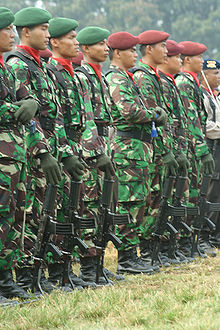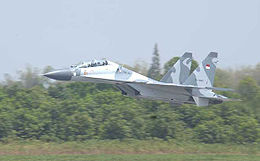- Indonesian National Armed Forces
-
Indonesian National Armed Forces
Tentara Nasional Indonesia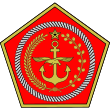
Insignia of Indonesian National Armed ForcesService branches  TNI AD (Army)
TNI AD (Army)
Headquarters Jakarta, Indonesia Leadership Supreme Commander of the Armed Forces President Susilo Bambang Yudhoyono Minister of Defence Purnomo Yusgiantoro Commander of the Armed Forces Admiral Agus Suhartono Manpower Available for
military service60,543,028, age 18–49 (2008 est.[1]) Fit for
military service52,000,000 males, age 18–49 (2008 est.[1]),
similar females, age 18–49 (2008 est.[1])Reaching military
age annually2,000,000 males (2008 est.[1]),
similar females (2008 est.[1])Active personnel 400,000 persons known Expenditures Budget $7.5 billion (2012) Percent of GDP 0.8% Industry Domestic suppliers PT Pindad, PT PAL, LAPAN, IAe, PT DAHANA, PT SRITEX, PT Sentra Surya Eka Jaya (SSE), CV Maju Mapan, PT Lundin Industry Invest, PT Fista Bahari Internusa Foreign suppliers  France
France
 United Kingdom
United Kingdom
 Russia
Russia
 United States
United States
 Germany
Germany
 People's Republic of China
People's Republic of China
 Republic of Korea
Republic of Korea
 Brazil
Brazil
 Canada
Canada
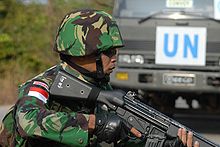
An Indonesian Army infantryman participating in the U.N.'s Global Peacekeeping Operation Initiative General Sudirman, first commander of the Indonesian Armed Forces
General Sudirman, first commander of the Indonesian Armed Forces
The Indonesian National Armed Forces (Indonesian: Tentara Nasional Indonesia, TNI; formerly Angkatan Bersenjata Republik Indonesia, ABRI) in 2009 comprises approximately 432,129 personnel including the Army (TNI-AD), Navy (TNI-AL) including the Indonesian Marine Corps (Korps Marinir) and the Air Force (TNI-AU).
The Indonesian Army was formed during the Indonesian National Revolution, when it undertook a guerrilla war along with informal militia. As a result of this, and the need to maintain internal security, the Army has been organized along territorial lines, aimed at defeating internal enemies of the state and potential external invaders.[2]
Under the 1945 Constitution, all citizens are legally entitled and obliged to defend the nation. Conscription is provided for by law, yet the Forces have been able to maintain mandated strength levels without resorting to a draft. Most enlisted personnel were recruited in their own home regions and generally trained and served most of their time in units nearby.
The Army is by far the largest part, with about 328,517 active-duty personnel, compared to around 74,963 in the Navy and 34,930 in the Air Force.[citation needed]. The Indonesian armed forces are voluntary. The available manpower fit for military service of males aged between 16 to 49 is 52,000,000, with a further 2,000,000 new suitable for service annually[3]
Military spending in the national budget was widely estimated 3% of GDP in 2005,[3] but is supplemented by revenue from many military-run businesses and foundations. The Indonesian Defence force personnel does not include members of law enforcement and paramilitary personnel such as POLRI (Indonesian police) consisting of approximately 540,000 personnel, BRIMOB (police mobile brigade) of around 39,000 armed personnel, the Civil Service Police Unit, MENWA (collegiate military service) 26,000 trained personnel, and HANSIP (civil defense forces), number unknown.
Contents
History
See also: Military history of IndonesiaFormation
Before the formation of the Indonesian Republic, the military authority in the Dutch East Indies was held by the Royal Dutch East Indies Army (KNIL). Although the KNIL is not directly responsible for the formation of the future Indonesian armed forces, and mainly took the role of foe during Indonesian National Revolution in 1945 to 1949, the KNIL had also provided military training and infrastructure for some of the future TNI officers. There were military training centers, military schools and academies in the Dutch East Indies. Next to Dutch volunteers and European mercenaries, the KNIL also recruited indigenous, especially Ambonese, Kai Islanders, Timorese, and Minahasan people. In 1940 with the Netherlands under German occupation and the Japanese pressing for access to Dutch East Indies oil supplies, the Dutch had opened up the KNIL to large intakes of previously excluded Javanese.[4][clarification needed] Some of the indigenous soldiers that had enjoyed Dutch KNIL military academy education would later become important TNI officers. For example: Suharto and Nasution.
Indonesian nationalism and militanism start to gain its momentum and support in World War II during Japanese occupation of Indonesia. To gain support from Indonesian people in their war against Western Allied force, Japan started to encourage and back Indonesian nationalistic movements by providing Indonesian youth with military trainings and weapons. On 3 October 1943, the Japanese military formed the Indonesian volunteer army called PETA (Pembela Tanah Air – Defenders of the Homeland). The Japanese intended PETA to assist their forces oppose a possible invasion by the Allies. The Japanese military trainings for Indonesian youth originally was meant to rally the local's support for the collapsing power of Japanese Empire, but later it has become the significant resource for Republic of Indonesia during Indonesian National Revolution in 1945 to 1949, and also has leads to the formation of Indonesian national armed force in 1945.
The Indonesian armed forces have seen significant action since their establishment in 1945. Their first conflict was the 1945–1949 Indonesian National Revolution, in which the 1945 Battle of Surabaya was especially important.
At first, The Indonesian Army started out as BKR (Badan Keamanan Rakjat – People's Security Corps), which was formed in the 3rd PPKI meeting, 29 August 1945; this was a Department in which People take up arms in the force to keep security intact over parts of independent Indonesia – it was much more of a civil defense force rather than an army. This decisions was made to make the allied forces would not invade Indonesia in full force. If they were made into an army, the allied forces might took it as a rebellion, for the Japanese had promised to return their Asian domains to the allies, not to liberate them independently.
Since confrontations had become sharp and hostile between Indonesia and the Allied forces, in December 1945 TKR (Tentara Keamanan Rakjat – People's Security Army) was formed; this was a move taken to formalize, unite, and organize the splintered pockets of independent troopers ('laskar') across Indonesia, of course also to give professional army approach, to contend with the Netherlands and the Allied force invaders.
In 1947, TRI (Tentara Rakjat Indonesia – Indonesian People Army) was then formed, this is to again professionalize the army to contend with the invaders, and, bearing its name of 'Tentara Rakjat' (People's Army), which meant it will be open to all layers of the residents of Indonesia, and, to legalize conscription drafts (Mobilisasi Rakjat – People's Mobilization).
In 1949 then, TRI changed its name to TNI, just like today.
Involvements in politics and regional conflicts
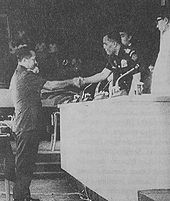 General Nasution congratulating General Suharto on the his appointment as acting president, 12 March 1967
General Nasution congratulating General Suharto on the his appointment as acting president, 12 March 1967
From 1950s to 1960s Republic of Indonesia struggles to maintain its unity against local insurgencies and separatist movements in some of its provinces. From 1948 to 1962 TNI involved in local warfare in West Java, Aceh, and South Sulawesi against Darul Islam/Tentara Islam Indonesia (DI/TII), a militant movement aimed to establish an Islamic state in Indonesia. Followed by the rebellion of Republic of South Maluku. The PRRI/Permesta rebellion is essential in Indonesian military history, because it was led army officers in Sumatra and Sulawesi between 1955 and 1961.
From 1961 to 1963, TNI involved in the military campaign to incorporate Western New Guinea into Indonesia, the military campaign was directed against Netherlands New Guinea. From 1962 to 1965 TNI fought in the Indonesia-Malaysia Confrontation. The Indonesian killings of 1965–1966 directly involved them, the armed forces under Lt. General Suharto was fighting against the Indonesian Communist with the help of the Western Bloc forces. The rise of General Suharto to the power as the new Indonesian president has promoted the role of military within Indonesian politics. During the New Order era Indonesian military enjoys certain privilege and play significant role in Indonesian politics. The military involvement in Indonesian politics was formulated in Dwifungsi (Dual function) doctrine of Indonesian Armed Force. Also during the New Order regime the "Tentara Nasional Indonesia" (Indonesian National Army/TNI) changed its name to "Angkatan Bersenjata Republik Indonesia" (Republic of Indonesia Armed Forces/ABRI) which also incorporated POLRI (Indonesian National Police).
In 1975 the Indonesian invasion of East Timor took place and a year afterward the Insurgency in Aceh began, which occurred on and off from 1976 to 2005. From 70s to 90s the Indonesian military worked hard to suppress and tackle down the armed insurgency and separatist movements in troubled provinces of Aceh and East Timor. In 1992 the Santa Cruz Massacre took place in East Timor, which tarnished the image of Indonesian military internationally. This incident led the United States to sever its IMET funding and link to Indonesian military, also banned arm equipments sales to Indonesia.
Also in 1992 each service began to form small female units. These all-female Corps are the Women's Army Corps, the Navy Women's Corps, the Air Force Women's Corps, and the Women's Corps of the Police. These were intended to "set to work at places and in functions conform[ing] to their feminine disposition." More specifically, women were assigned to administrative work, teaching English and working to improve health and social conditions of armed forces members and their families. The women police were said to "play an important role in solving problems [of] drug addicts and juvenile delinquents."[3]
After the Cold War ended the Indonesian Armed Forces began to take part in United Nations peacekeeping missions. These were usually known as 'Garuda' deployments. The first was to the United Nations Transitional Authority in Cambodia, quickly followed by a deployment as part of the United Nations Protection Force in Bosnia Herzegovina. Indonesian troops deployed to both the United Nations Operation in Somalia I and the United Nations Operation in Somalia II.
The strongest era
1961-1965: When many western countries still colonialized many countries in Africa and Asia, Indonesia had good relationship with Russia (formerly Soviet Union). Soviet Union gave 17 ships to Indonesian Navy which one of them was Sverdlov class cruiser, the biggest and fastest ship in this era. The size was 16,640 tons, very big compare to Indonesian current Sigma class corvette with only 1,600 tons. Indonesia had 12 Whiskey class submarine plus 2 supporting ships. Indonesia had more than a hundred military aircraft, 20 supersonic Mig-21, 10 supersonic Mig-19, 49 Mig-17 and 30 Mig-15. Mig-21 was more sophisticated than US and Dutch military aircraft. Indonesia also had 26 strategic bomber Tupolev Tu-16 followed US, Soviet Union and UK. Indonesia also support by more than 50 helicopters. All arsenal above became disfunction since Soeharto era and cooperation with western countries made Indonesia never have the strength arsenal as before.[5]
Reformation
After the fall of Suharto in 1998, the democratic and civil movement was grew against the acute military role and involvements in Indonesian politics. As the result, Post-Suharto Indonesian military has undergone certain reformations, such ad the disband of Dwifungsi doctrine and the terminations of military controlled business. The reformation also involved the law enforcement in common civil society, which questioned the position of Indonesian police under the military corps umbrella. This reformations leads to the separation of Police force from the military. In 2000, the Indonesian National Police officially regained its independence and now is a separate entity from the military. The official name of Indonesian military also change from "Angkatan Bersenjata Republik Indonesia" (ABRI) back to "Tentara Nasional Indonesia" (TNI).
Indonesian military continue its involvement and contribution in United Nations peacekeeping missions. After 1999, Indonesian troops went to Africa as part of the United Nations Mission in the Democratic Republic of Congo. The TNI has also served with the United Nations Interim Force in Lebanon.
Following the 2004 Indian Ocean earthquake, the United States government suspended a spare parts embargo which had been in place for non-lethal equipment and military vehicles, to support the humanitarian effort in the tsunami-devastated regions of Aceh and Nias. Since then the Indonesian Air Force has signed deals to purchase more C-130 transport aircraft and upgrade the current C-130s in the inventory. On 22 November 2005, the US announced that military ties with Indonesia would be restored in full. The decision had ended the six-year US ban on arms sales.[6]
In 2009, all former Indonesian military businesses are to be surrendered to a specialist body. The Indonesian Military Business Management Body (BPBTNI) was established in effect of a stipulation in Law No.34/2004 on the Indonesian Military (TNI) which will takeover ownership and operation of all businesses owned or run by the TNI by 2009. Unlike the former National Banking Restructuring Agency (BPPN) which burdened the Indonesian state with losses, the BPBTNI would bear all losses alone.[7]
Political role of the military
During the Suharto era, the military had a "dual function" (dwifungsi in Indonesian) defined as: firstly preservation and enforcement of internal and external security and sovereignty of the State and secondly, as an overseer and arbiter of government policy. This was used to justify substantial military interference in politics. Long-time president Suharto was an army general and was strongly supported by most of the military establishment. Traditionally a significant number of cabinet members had military backgrounds, while active duty and retired military personnel occupied a large number of seats in the legislature. Commanders of the various territorial commands played influential roles in the affairs of their respective regions.
Indonesia has not had a substantial conflict with its neighbours since the 1963–1965 Indonesia-Malaysia Confrontation, known in Indonesia as Konfrontasi with Malaysia. Possible future disputes relating to competing Malaysian-Indonesian South China Sea claims, where Indonesia has large natural gas reserves, concern the Indonesian government. As of 2007, some regional claims with neighbouring Malaysia have led to some minor sabre-rattling by both sides with a stalemate over the sovereignty of Unarang rock and the maritime boundary in the Ambalat oil block in the Celebes Sea.[3]
In the post-Suharto period since 1998, civilian and military leaders have advocated removing the military from politics (for example, the military's representation in the House of Representatives was reduced and finally ended), but the military's political influence remains extensive.
Philosophy and Doctrine
The Indonesian military philosophy over-riding defense of the archipelago is summarily civilian-military defense, called "Total People's Defense"- consisting of a three-stage war: a short initial period in which invader would defeat a conventional Indonesian military, a long period of territorial guerrilla war followed by a final stage of expulsion- with military acting as a rallying point for defence from grass-roots village level upwards. The doctrine relies on a close bond between villager and soldier to encourage the support of the entire population and enable the military to manage all war-related resources.
The civilian population would provide logistical support, intelligence, and upkeep with some trained to join the guerrilla struggle. The armed forces regularly engage in large-scale community and rural development. The "Armed Forces Enters the Village" (AMD) program, begun in 1983 is held three times annually to organise and assist construction and development of civilian village projects.[2]
Organization
The Indonesian armed forces have long been organized around territorial commands.[8] Following independence, seven were established by 1958. No central reserve formation was formed until 1961 (when the 1st Army Corps of the Army General Reserve, CADUAD, the precursor of today's Kostrad was established). It was only after the attempted coup d'état of 1 October 1965 and General Suharto's rise to the presidency that it became possible to integrate the armed forces and begin to develop a joint operations structure.
Following a decision in 1985, major reorganization separated the Ministry of Defense and Security [HANKAM] from the ABRI headquarters and staff.[9] HANKAM was made responsible for planning, acquisition, and management tasks but had no command or control of troop units. The ABRI commander in chief retained command and control of all armed forces and continued by tradition to be the senior military officer in the country. Since the separation of the ministry from the armed forces headquarters in 1985, the HANKAM staff has been composed largely of retired military personnel. The split provided positions of responsibility for highly qualified but relatively young retired officers of the Generation of 1945 while also opening up high level billets in ABRI to younger active-duty officers who had been frustrated by slow rates of promotion.
The administrative structure of HANKAM consisted of a minister, secretary general, inspector general, three directorates-general and a number of functional centers and institutes. The minister, inspector general, and three directors general were retired senior military officers; the secretary general (who acted as deputy minister) and most functional center chiefs were active-duty military officers.
The 1985 reorganization also made significant changes in the armed forces chain of command. The four multiservice Regional Defense Commands (Kowilhans) and the National Strategic Command (Kostranas) were eliminated from the defense structure, establishing the Military Regional Command (Kodam), or area command, as the key organization for strategic, tactical, and territorial operations for all services. The chain of command flowed directly from the ABRI commander in chief to the ten Kodam commanders, and then to subordinate army territorial commands. The former territorial commands of the air force and navy were eliminated from the structure altogether, with each of those services represented on the Kodam staff by a senior liaison officer. The navy and air force territorial commands were replaced by operational commands. The air force formed two Operations Commands (Ko-Ops) while the navy had its Eastern Fleet and Western Fleet—Armadas. The air force's National Air Defense Command (Kohanudna) remained under the ABRI commander in chief. It had an essentially defensive function that included responsibility for the early warning system.
The officer corps of the armed forces was estimated at 53,000 in 1992.[10] Less than 1 percent of these were of general officer rank. The Armed Forces Academy of the Republic of Indonesia (Akademi TNI), the national military academy at Magelang, Jawa Tengah Province trains most military officer corps. Mandatory retirement exists for officers at age fifty-eight and routine periodic reassignments are enforced.
Branches
The Indonesian Army was first formed in 1945 following the end of World War II and to protect the newly proclamated country, it initially consisted of local militia and grew to become the regular army of today.
In 1946, Indonesia became the second country (after Thailand/Siam) in South East Asia to acquire an Air Force capability, with the formation of the Indonesian Air Force. Presently, the Indonesian Air Force has 34,930personnel equipped with 510 aircraft including Su-27 and Su-30 fighters.
The Indonesian Navy was first formed on 22 August 1945, it became the second country (after Thailand/Siam) in South East Asia to acquire a navy capability. Current strength of the Indonesian Navy is around 74,000. In contrast to many other nations and military traditions, the Navy uses Infantry style ranks[11]
All Indonesian Navy aircraft are operated by the Indonesian Naval Aviation Service (DINAS PENERBANGAN TNI-AL). The Indonesian Navy has also purchased 8 Mi-2 (now based in Surabaya), but only two have arrived because of problems with the Indonesian Navy's agency. The Navy operates 52 fixed wing aircraft, and 23 combat and transport helicopters.[2]
The Indonesian Navy also includes the integral Indonesian Marine Corps (KorMar). It was created on 15 November 1945 and has the duties of being the main amphibious warfare force and quick reaction force of defence against enemy invasion.
While not strictly part of the armed forces, the Indonesian National Police often operate in a paramilitary role, independently or in cooperation with the other services on internal security missions. Indonesian Police use the name of POLRI (Kepolisian Republik Indonesia).
Budget
Fiscal Year Budget (IDR) Budget (USD) 2005 Rp 21.97 trillion USD 2.5 billion 2006 Rp 23.6 trillion USD 2.6 billion 2007 Rp 32.6 trillion USD 3.4 billion 2008 Rp 36.39 trillion USD 3.8 billion 2009 Rp 33.6 trillion USD 3.3 billion 2010 Rp 42.3 trillion USD 4.47 billion 2011 Rp 47.5 trillion USD 5.2 billion 2012 Rp 64.4 trillion[12] USD 7.5 billion List of commanders
Name Years Notes Lt. Gen. Urip Sumohardjo 17 August 1945 – 12 November 1945 Position held on an interim basis[13] Lt. Gen. Sudirman 12 November 1945 – 29 January 1950 Position known as Great Commander of the People's Security Army (Panglima Besar Tentara Keamanan Rakyat)[13] Maj. Gen. TB Simatupang 29 January 1950 – 1952 Position known as Chief of Staff of the Battle Forces (Kepala Staf Angkatan Perang)[13] Vacant 1952–1955 Position abolished by President Sukarno after the 17 October 1952 incident[13] Maj. Gen. Jenderal TNI A.H. Nasution December 1955 – March 1965 Position known as Chief of Staff of the Battle Forces (Kepala Staf Angkatan Perang)[13] Vacant 1965–68 Position abolished by President Sukarno after the 17 October 1952 incident[13] Gen. Suharto June 1968 – March 1973 Position known as Commander of the Armed Forces of the Republic of Indonesia (Panglima ABRI) as long as Minister of Defense and Security Gen. Maraden Panggabean March 1973 – April 1978 idem Gen. Andi Mohammad Jusuf April 1978 – 28 March 1983 idem Gen. Benny Moerdani 28 March 1983 – 27 February 1988 Also Commander of the Operational Command for the Restoration of Security and Order (Kopkamtib) Gen. Try Sutrisno 27 February 1988 – 19 February 1993 Gen. Edi Sudrajat 19 February 1993 – 21 May 1993 Also Minister of Defense and Security and Chief of Staff of the Army Gen. Feisal Tanjung 21 May 1993 – 12 February 1998 Gen. Wiranto 16 February 1998 – 26 October 1999 Position known as Commander of the Indonesian National Armed Forces (Panglima Tentara Nasional Indonesia) in 1999 as long as Minister of Defense and Security Adm. Widodo Adi Sutjipto 26 October 1999 – 7 June 2002 Gen. Endriartono Sutarto 7 June 2002 – 13 February 2006 ACM. Djoko Suyanto 13 February 2006 – 28 December 2007 Gen. Djoko Santoso 28 December 2007 – 28 September 2010 Adm. Agus Suhartono Since 28 September 2010 Notes
- ^ * CIA World Factbook Indonesia, accessed 25 July 2008
- ^ a b c *http://www.tni.mil.id
- ^ a b c d http://lcweb2.loc.gov/cgi-bin/query/r?frd/cstdy:@field(DOCID+id0171
- ^ McDonald (1980), pages 13
- ^ http://berdikarionline.com/opini/20100906/kejayaan-angkatan-perang-indonesia-pada-masa-bung-karno.html
- ^ National, World and Business News | Reuters.co.uk
- ^ *Antara News, "TNI Businesses To Be Taken Over by Special Body", [1], accessed 29 March 2009
- ^ Lowry, Bob (1993). Indonesian Defence Policy and the Indonesian Armed Forces, Canberra Papers on Strategy and Defence No.99, Strategic and Defence Studies Centre, Australian National University, 1993, p.36-40
- ^ Library of Congress Country Study, Indonesia, November 1992, Organization and Equipment of the Armed Forces
- ^ Library of Congress Country Study, Indonesia, 1992, link verified December 2009.
- ^ Tentara Nasional Indonesia
- ^ http://www.setneg.go.id/index2.php?option=com_content&do_pdf=1&id=5727
- ^ a b c d e f [2][dead link]
External links
- Official Website of TNI
- Official Website of the Department of Defense
- Indonesian Civil-Military Relations[dead link] – Civil-Military Relations in Post-Suharto Indonesia and the Implications for Democracy Today: A Preliminary Analysis
Further reading
- Bresnan, John. (1993). Managing Indonesia: the modern political economy. New York: Columbia University Press.
- Many topics, including the political role of the military at the height of Suharto's New Order.
- Chandra, Siddharth and Douglas Kammen. (2002). "Generating Reforms and Reforming Generations: Military Politics in Indonesia's Transition to Democracy." World Politics, Vol. 55, No. 1.
- Crouch, Harold. (1988). The army and politics in Indonesia. Ithaca:Cornell University Press.
- First published 1978. Now somewhat dated, but provides an influential overview of the role of the military in consolidating Suharto's power
- "Guerilla Warfare and the Indonesian Strategic Psyche" Small Wars Journal article by Emmet McElhatton
- Israel, Fauzi.(2009) – Advanced Weapon's Infantry Firepower & Accuracy
- Kammen, Douglas and Siddharth Chandra. (1999). A Tour of Duty: Changing Patterns of Military Politics in Indonesia in the 1990s. Ithaca, New York: Cornell Modern Indonesia Project No. 75.
- Kingsbury, Damen. Power Politics and the Indonesian Military, Routledge: 2003 ISBN 041529729X: 280 pages
Indonesian Navy (TNI–AL)
· Marine Corps (KorMar)Indonesian Air Force (TNI–AU)
· Special Forces (Paskhas)Life in Indonesia Architecture · Art · Communications · Cuisine · Culture · Demographics · Economy · Education · Ethnic groups · Fauna · Flora · Geography · Geology · Government · Health · History · Languages · Law · Literature · Media · Military · Music · People · Politics · Provinces · Religion · Science and technology · Sport · Tourism · Transport
Military of Asia Sovereign
states- Afghanistan
- Armenia
- Azerbaijan
- Bahrain
- Bangladesh
- Bhutan
- Brunei
- Burma (Myanmar)
- Cambodia
- People's Republic of China
- Cyprus
- East Timor (Timor-Leste)
- Egypt
- Georgia
- India
- Indonesia
- Iran
- Iraq
- Israel
- Japan
- Jordan
- Kazakhstan
- North Korea
- South Korea
- Kuwait
- Kyrgyzstan
- Laos
- Lebanon
- Malaysia
- Maldives
- Mongolia
- Nepal
- Oman
- Pakistan
- Philippines
- Qatar
- Russia
- Saudi Arabia
- Singapore
- Sri Lanka
- Syria
- Tajikistan
- Thailand
- Turkey
- Turkmenistan
- United Arab Emirates
- Uzbekistan
- Vietnam
- Yemen
States with limited
recognition- Abkhazia
- Nagorno-Karabakh
- Northern Cyprus
- Palestine
- Republic of China (Taiwan)
- South Ossetia
Dependencies and
other territories- Christmas Island
- Cocos (Keeling) Islands
- Hong Kong
- Macau
Categories:- Military of Indonesia
- Conscript militaries
Wikimedia Foundation. 2010.



